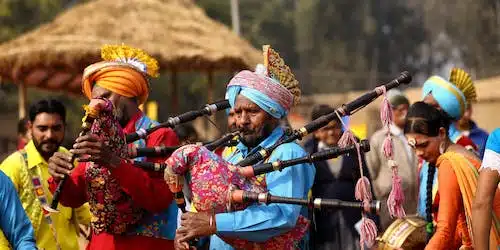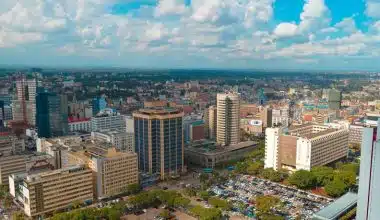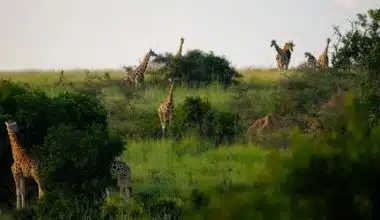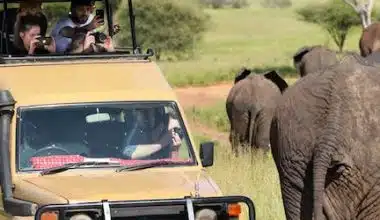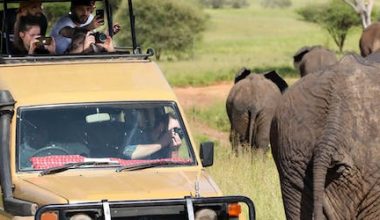Embark on a journey into the vibrant world of the Wodaabe tribe, where tradition, beauty, and nomadic life intertwine to create a captivating cultural tapestry. The Wodaabe tribe, a small Fulani ethnic group, is a nomadic pastoralist group in the Sahel region of Africa. They follow a code of ethics called “pulaaku” and emphasize beauty and charm. The tribe is considered wild by neighboring tribes and has a hierarchical social structure. The Tielebe Ritual marks the transition for Wodaabe boys. If your plan revolves around experiencing different cultures and traditions while on vacation, this is an opportunity to witness the Wodraabe tribe, as details are provided in this writing.
Wodaabe Tribe
The Wodaabe tribe is a group of nomadic pastoralists who reside in the Sahel region of Africa. They are a small branch of the Fulani ethnic group and are known for their unique cultural practises and emphasis on beauty and charm.
Features Of A Wodaabe Tribe
#1. Nomadic Lifestyle
The Wodaabe are nomadic pastoralists who migrate through the Sahel region of Africa, including countries like Niger, Chad, Nigeria, Cameroon, and the Central African Republic. They travel with their cattle and families, covering vast distances in their migratory journeys.
#2. Lineage Groups
The Wodaabe divide themselves into 15 lineage groups. Membership in these groups is determined by bloodlines and traveling together during the dry season. Marriages within the same lineage group are arranged during childhood and formally recognized by the Council of Elders.
#3. Code of Ethics
The Wodaabe follow a code of ethics called “pulaaku,” which emphasizes reserve, modesty, patience, fortitude, care, forethought, and loyalty.
#4. Emphasis on Beauty and Charm
Beauty and charm play a significant role in Wodaabe culture. The responsibility of establishing relationships falls on the men, who must impress women with their appearance and dance skills. The Wodaabe holds an annual courtship ritual called Gerewol, which is a beauty contest where men decorate their faces and dance for hours to impress female judges. The women may choose a winner as a potential mate.
#5. Perception by Neighboring Tribes
The Wodaabe are considered by neighbouring tribes to be wild and uncivilised people. They are often labelled as Mbororo or “cattle Fulani” due to their association with cattle camps.
The Wodaabe tribe has a hierarchical social structure. Each lineage group is led by a chief or elder who makes important decisions and resolves disputes within the group. The chief is assisted by a council of elders.
#7. Tielebe Ritual
The Tielebe ritual is an important initiation ceremony for Wodaabe boys. It marks their transition from childhood to adulthood. During this ritual, the boys receive teachings on their responsibilities as men and participate in rituals and dances.
#8. Music and Dance
Music and dance hold great significance in Wodaabe culture. They have a rich musical tradition with various instruments such as drums, flutes, and stringed instruments. Dance is used for various purposes, including courtship rituals, celebrations, and storytelling.
#9. Clothing and Adornments
The Wodaabe are known for their distinctive clothing and adornments. Men often wear flowing robes, colorful turbans, and intricate jewelry. Women typically wear elaborate head coverings and jewelry.
#10. Spiritual Beliefs
The Wodaabe have a belief system that combines elements of Islam and traditional animism. They believe in a supreme being and ancestral spirits. Rituals and ceremonies are performed to honor and communicate with these spiritual entities.
#1. Gerewol Festival
The Gerewol festival is a major cultural event for the Wodaabe tribe. It is a courtship ritual and beauty pageant where Wodaabe men adorn themselves with elaborate costumes, facial paintings, and jewelry to attract potential mates. Female judges play a crucial role in selecting winners, and the festival celebrates fertility and courtship.
#2. Cultural Identity
The Wodaabe have a strong cultural identity expressed through their language (Fula), distinctive attire, and adherence to values such as reserve, modesty, patience, care, and loyalty. They take pride in their traditions and maintain a sense of community and belonging.
The Wodaabe’s customs and traditions, such as lineage groups and arranged marriages, contribute to social differentiation within the tribe. Membership in specific lineage groups determines marriage eligibility, and marriages within the same group are common. This creates social distinctions and reinforces the importance of lineage and kinship ties.
#4. Gender Roles
The Wodaabe have distinct gender roles. Men participate in the Gerewol festival, where they compete for the attention of potential mates. Women play a role as judges in selecting winners. These gender-specific roles and rituals shape social dynamics and interactions within the tribe.
#5. Influence of Islam
While the Wodaabe have traditionally practiced animism, they have also been influenced by Islam, particularly in regions where Islam has spread. This religious influence can impact social dynamics, as individuals may adhere to Islamic beliefs and practices alongside their traditional customs.
Commercial Activities Of The Wodaabe Tribe
#1. Livestock Trade
As nomadic pastoralists, the Wodaabe tribe heavily relies on their herds of cattle. They engage in the trade of livestock, including cattle, goats, and sheep. Livestock serves as a source of food, milk, and income for the tribe. They may trade their animals with neighboring tribes or communities for goods such as grains, fabric, and tools.
#2. Livelihood Diversification
The Wodaabe tribe may engage in livelihood diversification strategies, such as migration and investment in various activities. Wealthier households within the tribe might be more likely to invest in migrants’ activities.
#3. Historical Commercial Centers
The Kingdom of Kanem, located near Lake Chad, flourished as a commercial center in West Africa from the 9th to the 14th century. While not directly related to the Wodaabe tribe, this historical context suggests the existence of commercial activities in the region.
#4.Trade and Islam
The Fulani people, of which the Wodaabe are a subgroup, have a history of trade and commerce. They were among the first Africans to convert to Islam and engaged in trade activities across western Sudan. However, it is unclear how extensively the Wodaabe tribe specifically participated in trade and commerce.
#5. Gemstone Trading
In some cases, Wodaabe fathers may identify sons who are responsible and intelligent enough to learn the gemstone trading business. This suggests that some members of the tribe may engage in gemstone trading as a livelihood diversification strategy.
#6. Interactions with Neighboring Tribes
The Wodaabe tribe interacts with neighboring tribes and communities for various trade purposes. They may engage in trade, exchanging goods and services with other groups in the region.
#7. Craftsmanship
Some members of the Wodaabe tribe engage in craftsmanship as a source of income. They create and sell handmade crafts, such as jewelry, baskets, leather goods, and traditional garments. These crafts are often sold to tourists or neighboring communities.
#8. Participation in Local Markets
When the Wodaabe tribe settles in a specific location, they may participate in local markets to sell their products, including livestock, agricultural produce, and handmade crafts. These markets provide opportunities for trade and economic interactions with other communities.
#9. Barter Trade
The Wodaabe tribe may engage in barter trade with neighboring tribes or communities. They exchange goods and services, such as livestock, milk, grains, and tools, in a mutually beneficial manner.
#10. Tourism
In recent years, the Wodaabe tribe has attracted attention from tourists interested in experiencing their unique culture and traditions. Some members of the tribe may engage in tourism-related activities, such as organizing cultural events, and performances, or offering cultural tours for visitors. This can provide additional income for the tribe.
Challenges Faced By The Wodaabe Tribe
The Wodaabe tribe faces various challenges, which can impact their way of life and overall well-being.
#1. Depletion of Herds
The Wodaabe tribe relies heavily on their livestock for sustenance and economic activities. However, factors such as droughts and environmental changes can lead to the depletion of their herds, affecting their livelihoods and traditional support systems.
#2. Limited Access to Resources
As a nomadic tribe, the Wodaabe face challenges in accessing essential resources such as water, grazing land, and healthcare facilities. The scarcity of these resources can impact their health, well-being, and economic activities.
#3. Climate Change
Like many indigenous communities, the Wodaabe tribe is vulnerable to the impacts of climate change. Changes in rainfall patterns, increased temperatures, and desertification can disrupt their traditional way of life, including livestock rearing and migration patterns.
#4. Cultural Preservation
The Wodaabe tribe faces the challenge of preserving their unique cultural practises and traditions in the face of modernization and external influences. Globalisation and the encroachment of modern lifestyles can pose a threat to their cultural identity and traditional knowledge.
#5. Healthcare Access
Access to adequate healthcare facilities and services can be limited for the Wodaabe tribe, especially in remote areas. This can result in challenges in addressing health issues and maintaining overall well-being.
#6. Education
Access to quality education can be a challenge for the Wodaabe tribe, particularly in remote areas. Limited infrastructure, lack of schools, and cultural barriers may hinder educational opportunities for Wodaabe children and youth, impacting their prospects.
#7. Land Encroachment and Displacement
The Wodaabe tribe faces the threat of land encroachment, as their traditional grazing lands may be infringed upon by expanding settlements, agriculture, or commercial activities. This can lead to displacement and loss of their ancestral lands, affecting their livelihoods and cultural practices.
#8. Political Marginalization
The Wodaabe tribe may face political marginalization, with limited representation and influence in decision-making processes. This can result in a lack of recognition and support for their rights, needs, and aspirations.
#9. Healthcare and Disease Prevention
Access to healthcare services and disease prevention can be a challenge for the Wodaabe tribe, particularly in remote areas. Limited healthcare infrastructure, a lack of trained medical personnel, and the spread of infectious diseases pose significant health risks.
#10. Poverty and Economic Vulnerability
The Wodaabe tribe, like many indigenous communities, faces economic challenges and poverty. Limited economic opportunities, fluctuating livestock markets, and dependency on seasonal resources make them vulnerable to economic shocks and hardships.
What Is the Wodaabe Tribe Known For?
The Wodaabe tribe is known for several aspects of their culture and traditions. They are renowned for their unique beauty contests, particularly the Gerewol festival, where Wodaabe men adorn themselves with elaborate costumes, facial paintings, and jewelry to showcase their beauty and charm. The festival serves as a celebration of fertility and is also a social event where important decisions regarding relationships and potential mates are made.
Are Wodaabe and Fulani The Same?
The Wodaabe tribe is a subgroup of the Fulani ethnic group. They are traditionally nomadic and primarily found in Niger and Chad. While the Wodaabe are part of the larger Fulani community, they have their own customs and cultural practises that pre-date those of other Fulani groups. The Wodaabe are known for their unique beauty contests, particularly the Gerewol festival, where Wodaabe men adorn themselves with elaborate costumes, facial paintings, and jewelry to showcase their beauty and charm. They also place great emphasis on cultural values such as reserve, modesty, patience, care, and loyalty.
What Are The Customs Of The Wodaabe Tribe?
The Wodaabe tribe has customs that include beauty contests, nomadic pastoralism, adherence to cultural values such as reserve and loyalty, distinctive attire and adornments, and marriage practices based on lineage. These customs contribute to their unique cultural identity.
What Animals Do The Wodaabe Tribe Have?
The Wodaabe tribe primarily raises cattle as part of their nomadic pastoralist lifestyle. They travel with their cattle across the arid areas of Niger, Nigeria, Cameroon, Chad, and the Central African Republic. Cattle are essential to their survival and play a significant role in their culture and economy. The Wodaabe are considered a branch of the Fulani ethnic group and are known as skilled cattle herders.
What Does The Wodaabe Tribe Believe In?
The beliefs of the Wodaabe tribe are influenced by their nomadic pastoralist lifestyle and cultural practices. It is known that the Wodaabe have traditionally practiced animism, which involves the belief in spirits and the worship of natural elements. However, the Wodaabe have also been influenced by Islam, particularly in regions where Islam has spread. Today, there are varying degrees of orthodoxy among the Wodaabe, with some still practicing pre-Islamic religious traditions alongside Islamic beliefs and practices.
What Is The Meaning Of Wodaabe?
The term “Wodaabe” is used to designate a subgroup of the Fula ethnic group, who are traditionally nomadic and primarily found in Niger and Chad. The name “Wodaabe” translates to “Cattle Fulani” or “those who dwell in cattle camps” in English. The Wodaabe culture is one of the 186 cultures included in the standard cross-cultural sample used by anthropologists to compare cultural traits.
Conclusion
The Wodaabe tribe’s traditions, including the Gerewol Festival, cultural identity, social differentiation, gender roles, and the influence of Islam, significantly influence their social dynamics. The festival celebrates fertility and courtship, while gender roles and religious practises shape their social roles and interactions within the tribe. They may engage in livelihood diversification strategies like migration and investment. Historical commercial centers like Kanem suggest commercial activities. The Wodaabe also engages in gemstone trading. These issues affect their livelihoods, health, and economic activities, and threaten their traditional way of life. Addressing these challenges is crucial for their well-being.
- ETHIOPIAN TRIBES: Exploring The Rich Cultural Heritage
- TRIBES IN AFRICA: Unveiling the Rich Traditions and Heritage
- ERITREAN PEOPLE: The Rich Cultural Heritage & Tradition
- SERENGETI SAFARI: All You Need to Know
